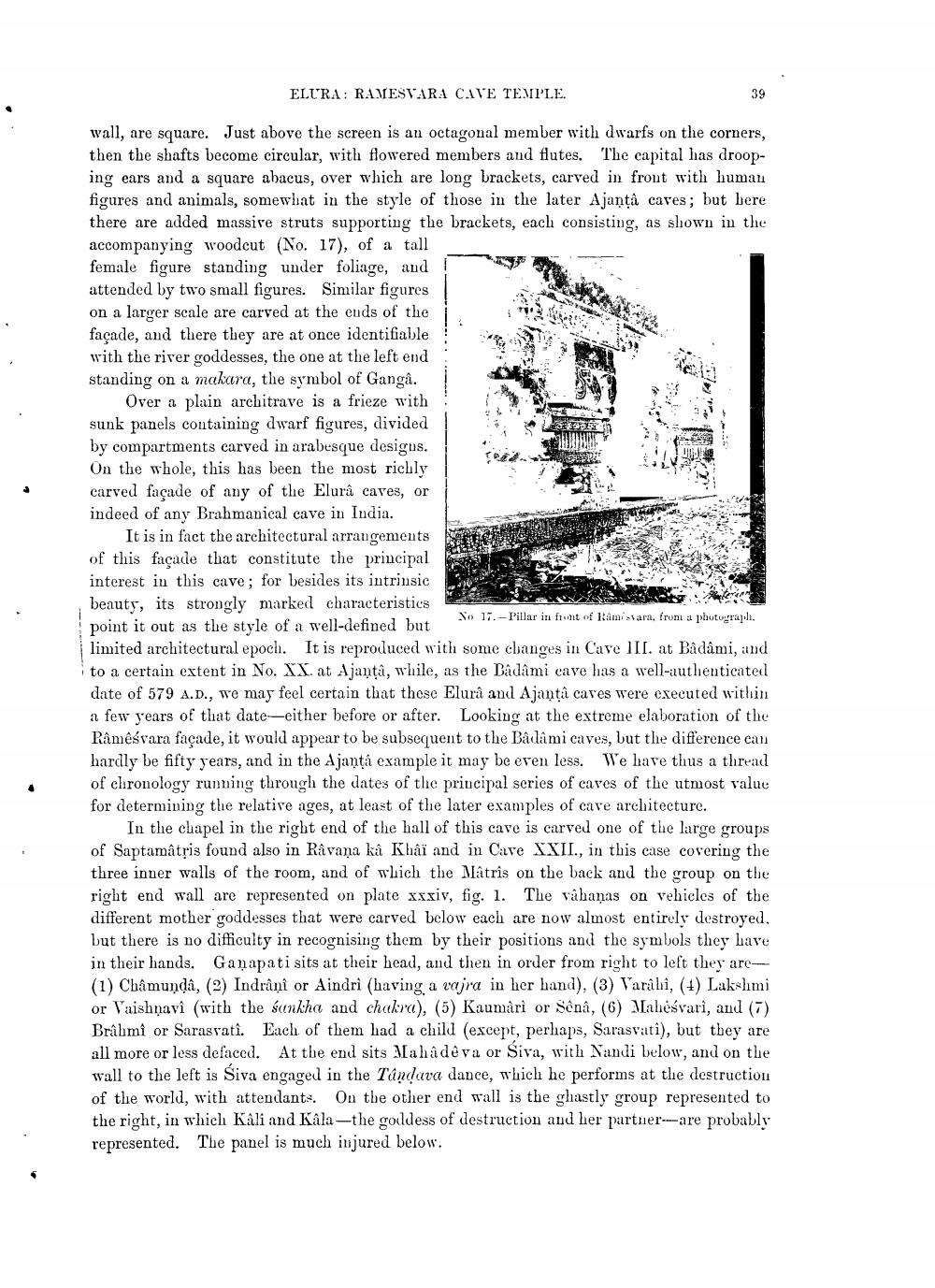________________
ELURA: RAJESVARA CIVE TEMPLE.
39
.
wall, are square. Just above the screen is an octagonal member with dwarfs on the corners, then the shafts become circular, with flowered members and flutes. The capital has drooping ears and a square abacus, over which are long brackets, carved in front with human figures and animals, somewhat in the style of those in the later Ajantà caves; but bere there are added massive struts supporting the brackets, each consisting, as shown in the accompanying woodcut (No. 17), of a tall female figure standing under foliage, and attended by two small figures. Similar figures on a larger scale are carved at the ends of the façade, and there they are at once identifiable with the river goddesses, the one at the left end standing on a makara, the symbol of Gangå.
Over a plain architrave is a frieze with sunk panels containing dwarf figures, divided by compartments carved in arabesque desigus.
oil AS On the whole, this has been the most richly carved façade of any of the Elurâ caves, or indeed of any Brahmanical cave in India.
It is in fact the architectural arrangements of this façade that constitute the principal interest in this cave; for besides its intrinsic beauty, its strongly marked characteristics
No 17.-Pillar in front of Kamisvara, front a photograph. point it out as the style of a well-defined but limited architectural epoch. It is reproduced with some changes in Cave III. at Badâmi, und to a certain extent in No. XX. at Ajantà, while, as the Badâmi cave has a well-authenticated date of 579 A.D., we may feel certain that these Elura and Ajantâ caves were executed within a few years of that date-either before or after. Looking at the extreme elaboration of the Râmêśvara façade, it would appear to be subsequent to the Bâdâ mi caves, but the difference can hardly be fifty years, and in the Ajanță example it may be even less. We have thus a thread of chronology ruming through the dates of the principal series of caves of the utmost value for determining the relative ages, at least of the later examples of care architecture.
In the chapel in the right end of the hall of this cave is carved one of the large groups of Saptamâtris found also in Råvana kå Khai and in Cave XXII., in this case covering the three inner walls of the room, and of which the Matris on the back and the group on the right end wall are represented on plate xxxiv, fig. 1. The vâhaņas on vehicles of the different mother goddesses that were carved below each are now almost entirely destroyed, but there is no difficulty in recognising them by their positions and the symbols they have in their hands. Ganapati sits at their head, and then in order from right to left they are(1) Châmundâ, (2) Indrâņi or Aindri (having a vajra in her hand), (3) Varâhi, (+) Lakshmi or Vaishnavi (with the sankha and chakra), (5) Kaumari or Sênâ, (6) Maleśvari, and (1) Brâhmî or Sarasvatî. Each of them had a child (except, perhaps, Sarasvati), but they are all more or less defaced. At the end sits Mahadeva or Siva, with Nandi below, and on the wall to the left is Śiva engaged in the Tandava dance, which he performs at the destruction of the world, with attendants. On the other end wall is the ghastly group represented to the right, in which Kali and Kala--the goddess of destruction and her partner-are probably represented. The panel is much injured below.




